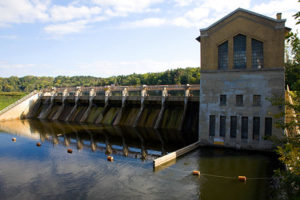Oh dam, there is plenty of hot news for us to share this June! After the multiple dam failures on the Tittabawasee River in May media coverage of local dams took off. We’ve shared a few of our favorite dam stories as well as news of emerging research on the presence of coal tar sealants in Great Lakes tributaries. There is also green infrastructure investments as an economic recovery strategy, and how PFAS will influence Michigan’s 2020 elections.

Focusing the recovery on green infrastructure could create millions of jobs
Despite the expectation that most employees will be rehired, many jobs are likely to not survive the COVID-19 pandemic. This op-ed argues that investments in clean energy and infrastructure could provide immense opportunities for economic recovery. Energy efficiency, grid improvement, sustainable transportation, and tree restoration would not only help fight climate change, but create nearly three times as many jobs as fossil fuel investments.
Prioritizing urban planning in combatting impacts of climate change
HRWC Board Chair Dr. Richard Norton, sat down with WEMU’s Issues Of The Environment to discuss dam management and urban planning related to climate change. Norton argues that current spending to rehabilitate aging dams in Michigan is not enough to ensure public safety, especially amidst increases in precipitation and flooding. Michigan is lacking both funding and a comprehensive strategy to address high hazard dams that require nearly billions in repairs.
Remove, repair or remain? Washtenaw County’s aging dams face expensive solutions
Despite recent dam failures on the Tittabawasee River, local Washtenaw County dams are still in decent condition. In an interview with MLive, HRWC Executive Director Rebecca Esselman, and Ann Arbor’s Water Treatment Services Manager, Brian Steglitz, discuss their perspectives on local dam management. Stegliz assures that Ann Arbor area dams are up-to-date on maintenance and have significant capacities to handle large flooding events.
Water pollutants in Michigan may sway swing voters in top races
As the 2020 elections grow closer, elected officials in Michigan are hoping their track records on PFAS contamination are enough to maintain their seats. Unlike other issues, water pollution concerns do not fall strictly along party lines in Michigan, making the issues key in recruiting swing voters over the coming months.
Coal-tar-sealant major source of PAH contamination in Great Lakes tributaries
Recent studies indicate runoff from pavement with coal-tar-based sealant is the most likely source of polycyclic aromatic hydrocarbons, or PAHs, in the sediments of Great Lakes tributaries. In the study, 71 streambed samples throughout the Great Lakes Basin revealed that coal-tar-sealants are driving PAHs concentrations at over 80 percent of the sites. PAHs have adverse impacts on aquatic life, underscoring the need for residents to make the switch to safer sealants.



